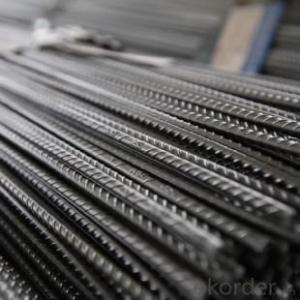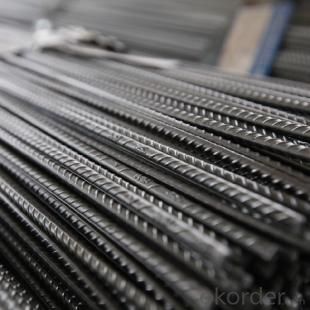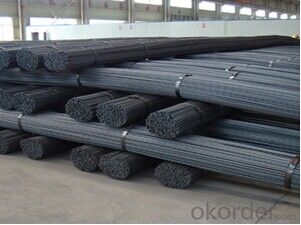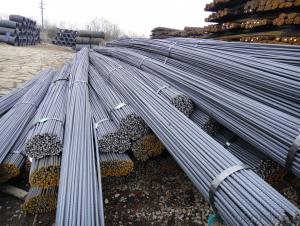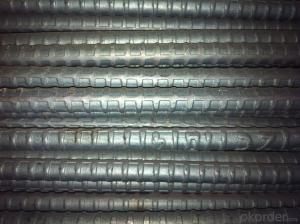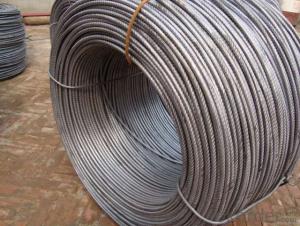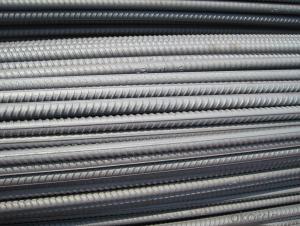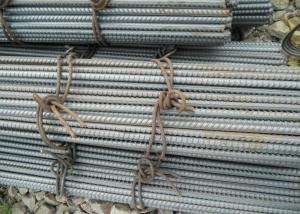GB Standard HRB400 Steel Deformed Bar 10mm/12mm
- Loading Port:
- Tianjin
- Payment Terms:
- TT or LC
- Min Order Qty:
- 25 m.t
- Supply Capability:
- 20000 m.t/month
OKorder Service Pledge
OKorder Financial Service
You Might Also Like
GB Standard HRB400 Steel Deformed Bar 10mm/12mm
Description:
-Standard: GB
-Material: HRB400
-Specification:
| Diameter(mm) | Section Area(mm2) | Mass(Kg/m) | Length(m) |
| 10 | 78.54 | 0.617 | 9, 12 or as customs' request |
| 12 | 113.1 | 0.888 | 9, 12 or as customs' request |
Chemical Composition(%) of GB Standard HRB400 Steel Deformed Bar 10mm/12mm:
| C | Mn | Si | S | P | V |
| ≤0.25 | ≤1.60 | ≤0.08 | ≤0.045 | ≤0.045 | 0.04-0.12 |
Mechanical Properties of GB Standard HRB400 Steel Deformed Bar 10mm/12mm:
Yield Strength (N/cm²) | Tensile Strength (N/cm²) | Elongation (%) |
≥400 | ≥570 | ≥14 |
Usage and Applications of GB Standard HRB400 Steel Deformed Bar 10mm/12mm:
Deformed bar is widely used in buildings, bridges, roads and other engineering construction. Big to highways, railways, bridges, culverts, tunnels, public facilities such as flood control, dam, small to housing construction, beam, column, wall and the foundation of the plate, deformed bar is an integral structure material. With the development of world economy and the vigorous development of infrastructure construction, real estate, the demand for deformed bar will be larger and larger.
Packaging & Delivery of GB Standard HRB400 Steel Deformed Bar 10mm/12mm:
Packaging Detail: products are packed in bundle and then shipped by container or bulk vessel, deformed bar is usually naked strapping delivery, when storing, please pay attention to moisture proof. The performance of rust will produce adverse effect.
Each bundle weight: 2-3MT, or as required
Payment term: TT or L/C
Delivery Detail: within 45 days after received advanced payment or LC.
Label: to be specified by customer, generally, each bundle has 1-2 labels
Trade terms: FOB, CFR, CIF
Images of GB Standard HRB400 Steel Deformed Bar 10mm/12mm:
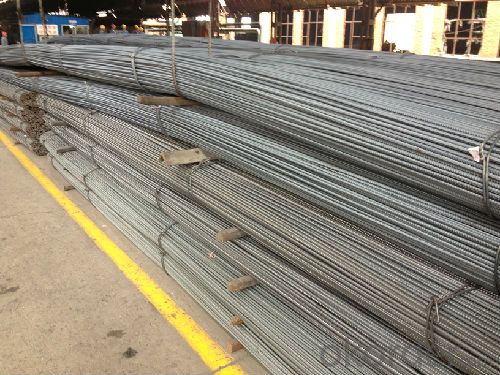
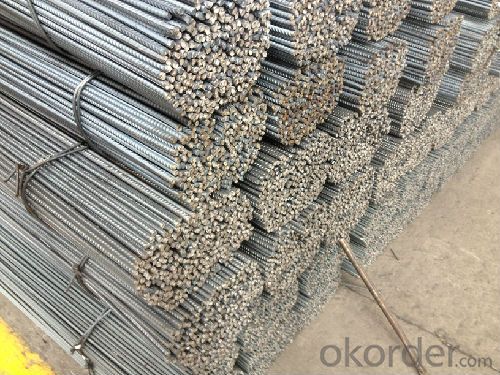
*If you would like to get our price, please inform us the size, standard/material and quantity. Thank you very much for your attention.
- Q: Can steel rebars be used in foundations and footings?
- Certainly, steel rebars are suitable for use in foundations and footings. In fact, these applications commonly employ steel rebars owing to their exceptional tensile strength and durability. Typically composed of carbon steel, steel rebars reinforce concrete structures effectively, bolstering their resistance against tension and bending forces. By integrating rebars into the concrete, additional strength is provided, mitigating the risk of cracking or failure when subjected to heavy loads. Consequently, utilizing steel rebars in foundations and footings is an established construction practice, guaranteeing the stability and longevity of the structure.
- Q: What is the ductility of steel rebars?
- Steel rebars are capable of deforming and stretching without fracturing while under tension or bending, which is what ductility refers to. The excellent ductility exhibited by steel rebars enables them to effectively absorb and disperse energy when exposed to heavy loads or seismic forces. This attribute is crucial in construction as it guarantees that the rebars can endure harsh conditions while maintaining the structural integrity. Additionally, the ductility of steel rebars renders them suitable for numerous applications, including reinforcing concrete structures and providing support for buildings, bridges, and other infrastructure projects.
- Q: Can steel rebars be used in marine or coastal construction projects?
- Yes, steel rebars can be used in marine or coastal construction projects. However, it is important to ensure that the rebars are made of corrosion-resistant steel or are properly protected against corrosion. This is because the salty and humid environment in marine or coastal areas can accelerate the corrosion process, which can compromise the structural integrity of the rebars and the overall construction.
- Q: What is the purpose of steel rebars?
- The purpose of steel rebars is to reinforce concrete structures, providing strength and stability by counteracting tensile forces and preventing cracks or failure under pressure.
- Q: How are steel rebars used in airport runway construction?
- Steel rebars are used in airport runway construction to reinforce and strengthen the concrete pavement. They are placed within the concrete to provide additional support and prevent cracking or shifting of the runway surface under heavy aircraft loads.
- Q: Can steel rebars be used in the construction of dams or reservoirs?
- Yes, steel rebars can be used in the construction of dams or reservoirs. Steel rebars provide structural reinforcement and enhance the strength and durability of concrete structures, making them suitable for large-scale projects like dams and reservoirs.
- Q: Can steel rebars be used in underground construction projects?
- Yes, steel rebars can be used in underground construction projects. Rebars are commonly used in all types of construction projects, including underground structures. The main purpose of steel rebars is to reinforce concrete and provide additional strength and stability to the structure. In underground construction, rebars are often used in the construction of foundations, walls, and columns to strengthen the concrete and ensure the integrity of the structure. The use of steel rebars in underground construction projects helps to increase the load-bearing capacity of the concrete, making it more resistant to the pressure and forces exerted by the surrounding soil and groundwater. Additionally, steel rebars are highly durable and resistant to corrosion, which makes them suitable for underground environments where they may be exposed to moisture and other potentially damaging elements. Overall, the use of steel rebars in underground construction projects is essential for ensuring the structural stability and longevity of the underground structures.
- Q: What is the maximum allowable stress for steel rebars?
- The maximum allowable stress for steel rebars typically depends on the grade of steel being used. However, in most cases, the maximum allowable stress for steel rebars ranges from 40,000 to 60,000 pounds per square inch (psi).
- Q: Can steel rebars be used in structures with limited foundation support?
- Steel rebars are suitable for structures with limited foundation support. They are frequently employed as reinforcement in concrete structures to augment their strength and longevity. In situations where the foundation support is insufficient, steel rebars aid in distributing the load evenly across the structure, thereby reducing the strain on the foundation. Moreover, incorporating steel rebars can enhance the overall stability of the structure. It is crucial, however, to emphasize that a qualified engineer should be responsible for designing and placing the rebars in order to ensure their seamless integration into the structure and their ability to effectively bear the load.
- Q: Are steel rebars suitable for reinforcement in residential buildings?
- Yes, steel rebars are suitable for reinforcement in residential buildings. They provide strength and durability to the structure, making it more resistant to various forces such as earthquakes and heavy loads. Steel rebars can effectively reinforce concrete, ensuring the stability and safety of residential buildings.
Send your message to us
GB Standard HRB400 Steel Deformed Bar 10mm/12mm
- Loading Port:
- Tianjin
- Payment Terms:
- TT or LC
- Min Order Qty:
- 25 m.t
- Supply Capability:
- 20000 m.t/month
OKorder Service Pledge
OKorder Financial Service
Similar products
Hot products
Hot Searches
Related keywords
